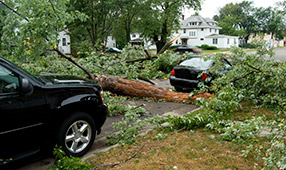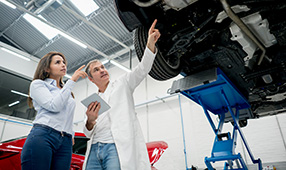Winter is right around the corner. Now’s the time to start winterizing your home to help curb high utility bills and your car to help prevent unexpected car repairs. Here are five quick tips to get you started.
1. Have a pro inspect your HVAC system
Heating your home is a large chunk of your energy bill, so it’s important to have your home heating system checked regularly to make sure it’s running at peak efficiency. If it’s struggling due to old, dirty filters or failing components, your energy costs can go up.
EnergyStar.gov recommends having your system tuned up once per year. Contact a qualified HVAC contractor to inspect your system.
2. Install a programmable thermostat
One of the easiest ways to manage your energy use is to install a programmable thermostat. (Although there are special considerations if you have a heat pump.) These thermostats can automatically adjust the temperature in your home at certain times of the day.
Dialing back your thermostat about 7-10 degrees for 8 hours a day can cut your home heating costs by about 10%, depending on the severity of your climate. Also, you can lower your home’s temperature even further while the house is empty during the day, and then turn it up about the time you come home. You’ll find plenty of programmable thermostats at different prices and with different features.
3. Use curtains strategically
It sounds almost too simple, but use the sun to your advantage! Open the curtains of south-facing windows to let the sun heat your home. Close them at night to keep out the cold. For a boost, try lined, insulated curtains; they can help prevent heat loss, block drafts and keep out some of the cold.
4. Switch to LED lights, inside and out
Love to light up your house for the holidays? Do you put up decorations for Halloween and keep your house brightly lit with cheery colors through St. Patrick’s Day? Save on electricity costs by switching to LED lights. Most decorations now have LED counterparts.
While LEDs can be a more expensive initial investment, they can last much longer than traditional bulbs, so your long-term replacement cost can be less—and less frustrating thanks to fewer burned out bulbs! LEDs also produce less heat and use less electricity, so over the long haul you’ll see savings.
5. Be proactive about winter car maintenance
Change your battery if it’s old, check and replace worn belts and top off important fluids. Taking care of the small things now can help you avoid a costly break-down and expensive towing charges later.
And as the temperature drops, so can your tires’ air pressure. Inflating them to the correct pressure can save you money on gas. For more information about winterizing your car read “Get Ready for Winter With Our Car-care Checklist.”
Bonus tip
Use your NEA member benefits! Save on a programmable thermostat, insulated curtains or even LED holiday lights when you shop at well-known retailers through NEA Discount Marketplace.












